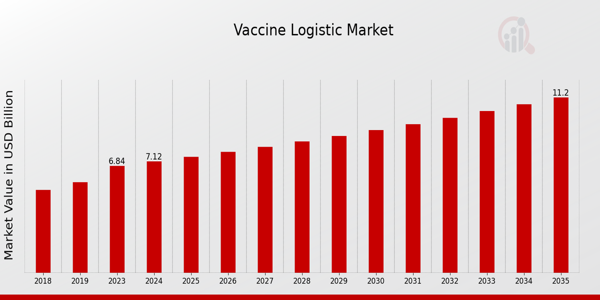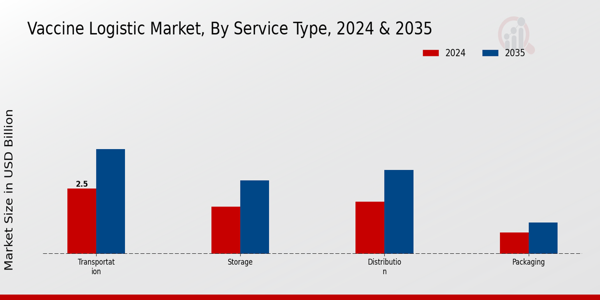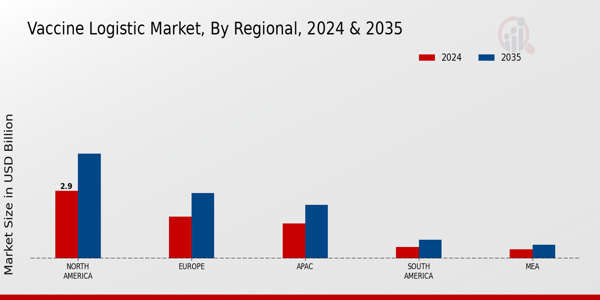Vaccine Logistic Market Overview
The Vaccine Logistic Market Size was estimated at 6.84 (USD Billion) in 2023. The Vaccine Logistic Industry is expected to grow from 7.12(USD Billion) in 2024 to 11.2 (USD Billion) by 2035. The Vaccine Logistic Market CAGR (growth rate) is expected to be around 4.2% during the forecast period (2025 - 2035).
Key Vaccine Logistic Market Trends Highlighted
The global vaccine logistic market is driven by several key factors, including the increasing demand for vaccines, which is driven by rising infectious diseases and pandemic preparedness. The growth in vaccine research and development, coupled with the need for efficient distribution channels, has placed a premium on reliable logistics solutions. Advancements in temperature-controlled transportation and storage facilities also play a significant role in ensuring that vaccines maintain efficacy throughout their supply chain journey. Furthermore, increased collaboration between pharmaceutical companies and logistics providers is essential for optimizing these operations and ensuring timely delivery.
There are many chances for development in the logistics sector within cold chain management and even logistics networks of the developing regions. The growing tendency of personalized medicines and new types of vaccines, for example mRNA vaccines, give considerable logistical problems requiring clever logistical management. Also, the increasing need for sustainability and green solutions gives room for companies to stand out through green logistics. And as the market grows, investment in IoT and blockchain technology may offer greater transparency and tracking of the supply chain which is appealing to health authorities and consumers.
Recent trends indicate a growing emphasis on digital transformation within vaccine logistics. The adoption of advanced tracking and monitoring systems has become crucial for ensuring compliance and minimizing the risk of spoilage. Furthermore, the increase in partnerships between logistics firms and manufacturers facilitates a more integrated approach, enhancing service delivery and efficiency. These trends highlight the importance of adaptability and innovation in the logistics framework to meet the unique demands of the vaccine market, supporting global health initiatives and improving access to vaccines worldwide.

Source: Primary Research, Secondary Research, MRFR Database and Analyst Review
Vaccine Logistic Market Drivers
Increasing Vaccine Demand Due to Rising Infectious Diseases
The Global Vaccine Logistic Market Industry is experiencing significant growth driven by the increasing demand for vaccines due to the rise in infectious diseases. As global health challenges grow, the need for effective immunization programs becomes paramount. Factors such as urbanization, climate change, and the emergence of new pathogens contribute to the rise in infectious diseases, leading to a heavier reliance on vaccines as a preventive measure.Government initiatives to strengthen vaccination programs, alongside public awareness campaigns about the importance of vaccinations, are creating a robust market demand. Additionally, the ongoing need for vaccination against diseases like influenza, measles, and, more recently, COVID-19 emphasizes the urgency of efficient vaccine logistics to ensure timely delivery and distribution. The Global Vaccine Logistic Market Industry must, therefore, adapt to these growing demands by enhancing supply chain infrastructures, implementing real-time tracking and monitoring technologies, and ensuring strict adherence to temperature control measures during transportation.The increasing complexity of vaccine management necessitates comprehensive logistical solutions to facilitate the extensive reach and accessibility of vaccines globally. This trend presents significant opportunities for stakeholders in the Global Vaccine Logistic Market Industry to innovate and expand their services, ultimately fostering market growth and sustainability.
Government Initiatives and Funding
Government initiatives and funding play a crucial role in driving the Global Vaccine Logistic Market Industry. Many governments around the world are committing substantial resources to enhance their public health systems and expedite vaccine distribution processes. This includes funding for infrastructure improvements, research and development, and partnerships with private organizations to streamline logistics and vaccine delivery. As governments prioritize the health and well-being of their populations, they are increasingly focused on ensuring access to vaccines, which ultimately supports market growth.
Technological Advancements in Vaccine Distribution
Technological advancements are key drivers facilitating growth in the Global Vaccine Logistic Market Industry. Innovations such as temperature-controlled transportation, real-time tracking systems, and automated inventory management are enhancing the efficiency and effectiveness of vaccine distribution. These technologies not only improve patient safety by ensuring that vaccines are stored and transported under optimal conditions but also help organizations reduce waste and lower operational costs.As technology continues to evolve, the Global Vaccine Logistic Market Industry stands to benefit immensely.
Vaccine Logistic Market Segment Insights
Vaccine Logistic Market Service Type Insights
The Global Vaccine Logistic Market displays a well-structured segmentation according to Service Type, encompassing critical components such as Transportation, Storage, Distribution, and Packaging. In 2024, the market is expected to showcase a value of 7.12 USD Billion, with Transportation holding significant importance, valued at 2.5 USD Billion. This segment is crucial as it ensures that vaccines reach healthcare providers promptly and securely, thereby having the majority holding in the overall market through efficient logistics channels. Storage emerges as another vital aspect, projected to be valued at 1.8 USD Billion in 2024; it plays a significant role in maintaining the quality and efficacy of vaccines through proper temperature management and monitoring systems.Meanwhile, Distribution is expected to record a valuation of 2.0 USD Billion, providing essential infrastructure for vaccine supply across various regions, ensuring equitable access and timely delivery. The Packaging segment, while smaller, valued at 0.82 USD Billion in 2024, is not to be overlooked, as it is critical for protecting the integrity of vaccines during transit and maintaining compliance with safety regulations. As the Global Vaccine Logistic Market expands, these service segments are poised for growth, driven by increasing global vaccination efforts and the need for efficient logistics solutions.The market dynamics reveal that Transportation and Distribution stand out as significant contributors, representing the backbone of vaccine logistics by ensuring that healthcare systems can effectively respond to vaccination drives. However, Storage and Packaging should not be diminished, as they uphold the required standards for vaccine handling. The integration of advanced technologies and growing awareness around vaccine distribution challenges are anticipated to bolster these service types, thus paving the way for improved Global Vaccine Logistic Market statistics moving toward 2035.

Source: Primary Research, Secondary Research, MRFR Database and Analyst Review
Vaccine Logistic Market Temperature Control Insights
The Temperature Control segment within the Global Vaccine Logistics Market is crucial to ensuring safe and effective vaccine transport and storage. As of 2024, the overall market is set to be valued at approximately 7.12 billion USD, reflecting a growing recognition of the importance of temperature-sensitive transport. This segment plays a significant role due to the delicate nature of vaccines that require strict temperature maintenance. Among the different storage environments, Refrigerated transport is the most widely utilized, owing to its critical function in preserving vaccine potency.Frozen storage also holds importance, particularly for vaccines that require ultra-low temperature conditions, while Ambient conditions address the unique needs of specific vaccine types. The ongoing trends towards improving cold chain infrastructure, along with an increase in vaccination campaigns globally, drive a robust market growth trajectory. Challenges such as logistics management in remote areas and rising energy costs remain. However, opportunities exist for innovative technologies to optimize temperature control systems, making the Global Vaccine Logistic Market a dynamic sector with evolving strategies to enhance operational efficiency.With a forecasted valued growth of 11.2 billion USD by 2035, the segment remains a focal point for stakeholders in the Global Vaccine Logistic Market industry.
Vaccine Logistic Market End User Insights
The Global Vaccine Logistic Market is poised for notable growth, particularly within the End User segment, which comprises key players including Pharmaceutical Companies, Government Organizations, Healthcare Providers, and Non-Governmental Organizations. By 2024, the market is expected to be valued at 7.12 USD billion, highlighting the extensive engagement of these stakeholders in optimizing vaccine distribution and storage. Pharmaceutical Companies play a crucial role as they are directly involved in the production and delivery of vaccines, ensuring compliance with safety and efficacy standards.Government Organizations are significant contributors, as they manage vaccination programs and public health initiatives, often providing substantial funding and logistical support. Healthcare providers dominate the distribution chain alongside non-governmental organizations that enhance accessibility and delivery in underserved areas. This diverse involvement underscores the collaborative effort essential for effective vaccine logistics management, reflected in the overall Global Vaccine Logistic Market statistics and data trends. As the industry evolves, opportunities arise to enhance collaboration among these entities, driving efficiencies and innovations in vaccine logistics amid ongoing global health challenges.
Vaccine Logistic Market Mode of Transportation Insights
The Global Vaccine Logistic Market is projected to be valued at 7.12 USD Billion by 2024, reflecting a steady growth within the Mode of Transportation segment. This sector is vital for ensuring the efficient distribution of vaccines globally, influenced by various dynamics like emerging health crises and increasing vaccination programs. Air Cargo plays a critical role in the rapid transport of vaccines, making it essential for timely deliveries, especially in regions facing outbreaks. Road Transport also holds significant importance, facilitating last-mile delivery to healthcare facilities, thereby ensuring vaccines reach their destinations efficiently.Additionally, Sea Freight provides a cost-effective solution for shipping larger quantities of vaccines over long distances, although it requires more time. Together, these modes create a comprehensive logistics strategy that addresses diverse distribution needs, making the Mode of Transportation a cornerstone of the Global Vaccine Logistic Market industry. The interplay of these logistics methods supports a seamless flow in vaccine supply chains while growing population health awareness drives further demand for effective vaccine logistics solutions, which is reflected in the Global Vaccine Logistic Market statistics and data reflecting future growth.
Vaccine Logistic Market Regional Insights
The Global Vaccine Logistic Market is set to experience substantial growth across various regions, with North America leading as a major contributor, valued at 2.9 USD Billion in 2024 and expected to reach 4.5 USD Billion by 2035. This dominance reflects the region's robust healthcare infrastructure and high vaccination rates, which drive significant demand for efficient logistics. Europe follows with a valuation of 1.8 USD Billion in 2024, rising to 2.8 USD Billion by 2035, indicating a strong market presence driven by increasing investments in healthcare logistics.The APAC region, valued at 1.5 USD Billion in 2024 and 2.3 USD Billion in 2035, is witnessing rapid expansion due to rising populations and the growing need for vaccine distribution networks. South America, with a valuation of 0.5 USD Billion in 2024 and 0.8 USD Billion in 2035, shows potential for development as vaccination efforts intensify. Meanwhile, the MEA region, starting at 0.4 USD Billion in 2024 and growing to 0.6 USD Billion in 2035, faces challenges but presents opportunities for market penetration, particularly with increased international aid and investment.Overall, the Global Vaccine Logistic Market segmentation illustrates a diverse landscape characterized by varying growth rates and opportunities across these regions.

Source: Primary Research, Secondary Research, MRFR Database and Analyst Review
Vaccine Logistic Market Key Players and Competitive Insights:
The Global Vaccine Logistic Market is increasingly vital to ensuring that vaccines are delivered efficiently and effectively worldwide, particularly in the face of recent global health challenges. This market encompasses various activities involved in the distribution and storage of vaccines, including transportation, cold chain management, and tracking systems. The landscape is characterized by a blend of major players, emerging companies, and local service providers, all vying for a share of the market. Companies that excel in this field not only require advanced logistical capabilities and technologies but also must navigate complex regulatory environments and maintain robust supply chains. Staying competitive necessitates strategic partnerships, continuous innovation, and responsiveness to changing market demands, particularly as vaccine development and distribution processes evolve.Pfizer stands out in the Global Vaccine Logistic Market primarily due to its robust infrastructure and extensive experience in vaccine manufacturing and distribution. The company has developed a comprehensive logistics network that integrates cutting-edge technology to monitor temperature-controlled environments and ensure the integrity of vaccines throughout the supply chain. Pfizer’s expertise in global distribution has positioned it as a leader in timely vaccine delivery, which has proven indispensable during health emergencies. The company has also established strategic partnerships with logistics providers, allowing it to leverage additional resources and capabilities to enhance its distribution efficiency. Furthermore, Pfizer’s strong focus on regulatory compliance reassures stakeholders about the safety and efficacy of delivered products, solidifying its reputation in the market.Roche has made a significant impact on the Global Vaccine Logistic Market with its emphasis on innovative solutions and collaboration. The company has invested in state-of-the-art logistics technologies that facilitate accurate tracking and monitoring of vaccine shipments, ensuring that they are transported in optimized conditions. Roche focuses on building strong relationships with healthcare providers and logistic partners, which enhances its capability to respond quickly to changing demands and supply chain challenges. The company's commitment to sustainability also plays a critical role in its logistics strategy, attempting to reduce the environmental impact of vaccine distribution. Roche’s established presence in key markets globally allows it to efficiently manage operations while maintaining a strong supply chain network that is crucial for the timely delivery of vaccines, particularly in underserved areas.
Key Companies in the Vaccine Logistic Market Include:
- Pfizer
- Roche
- DHL
- GSK
- International Vaccine Institute
- Moderna
- UPS
- World Courier
- Kuehne + Nagel
- Cegelec
- FedEx
- DB Schenker
- McKesson
- Thermo Fisher Scientific
- CVS Health
Vaccine Logistic Market Industry Developments
Recent developments in the Global Vaccine Logistics Market have shown a marked increase in demand for efficient distribution services, especially highlighted by companies like DHL and FedEx. These organizations have reported enhancements in their cold chain logistics to accommodate vaccines requiring stringent temperature controls. The ongoing COVID-19 vaccination efforts have further underscored the importance of timely delivery and distribution solutions provided by firms such as UPS and World Courier. Collaborations have intensified among key players, with GSK and Moderna focusing on partnerships aimed at streamlining logistic processes to ensure faster vaccine rollout. Additionally, Kuehne + Nagel and DB Schenker are expanding their logistics capabilities to support global vaccine distribution effectively. Recent market activity also indicates that significant mergers and acquisitions are on the horizon as companies like Thermo Fisher Scientific and Roche seek to bolster their positions in the logistical landscape. The focus on investment in cold storage infrastructure and technology advancements is reshaping the market dynamics, significantly affecting companies' valuations within the sector. Major players are adapting to these changes to maintain a competitive edge and efficiently meet the rising demands for vaccine logistics.
Vaccine Logistic Market Segmentation Insights
Vaccine Logistic MarketService TypeOutlook
- Transportation
- Storage
- Distribution
- Packaging
Vaccine Logistic Market Temperature Control Outlook
- Refrigerated
- Frozen
- Ambient
Vaccine Logistic Market End User Outlook
- Pharmaceutical Companies
- Government Organizations
- Healthcare Providers
- Non-Governmental Organizations
Vaccine Logistic Market Mode of TransportationOutlook
- Air Cargo
- Road Transport
- Sea Freight
Vaccine Logistic Market RegionalOutlook
- North America
- Europe
- South America
- Asia Pacific
- Middle East and Africa
Scope
| Attribute/Metric Source: |
Details |
| MARKET SIZE 2023 |
6.84(USD Billion) |
| MARKET SIZE 2024 |
7.12(USD Billion) |
| MARKET SIZE 2035 |
11.2(USD Billion) |
| COMPOUND ANNUAL GROWTH RATE (CAGR) |
4.2% (2025 - 2035) |
| REPORT COVERAGE |
Revenue Forecast, Competitive Landscape, Growth Factors, and Trends |
| BASE YEAR |
2024 |
| MARKET FORECAST PERIOD |
2025 - 2035 |
| HISTORICAL DATA |
2019 - 2024 |
| MARKET FORECAST UNITS |
USD Billion |
| KEY COMPANIES PROFILED |
Pfizer, Roche, DHL, GSK, International Vaccine Institute, Moderna, UPS, World Courier, Kuehne + Nagel, Cegelec, FedEx, DB Schenker, McKesson, Thermo Fisher Scientific, CVS Health |
| SEGMENTS COVERED |
Service Type, Temperature Control, End User, Mode of Transportation, Regional |
| KEY MARKET OPPORTUNITIES |
Increased demand for cold chain solutions, Advanced tracking and monitoring technologies, Expansion into emerging markets, Partnerships with healthcare providers, Investment in automation and AI. |
| KEY MARKET DYNAMICS |
increased vaccine demand, cold chain requirements, regulatory compliance, technological advancements, supply chain optimization |
| COUNTRIES COVERED |
North America, Europe, APAC, South America, MEA |
Frequently Asked Questions (FAQ) :
The Global Vaccine Logistic Market is expected to be valued at 7.12 billion USD in 2024.
By 2035, the Global Vaccine Logistic Market is projected to reach 11.2 billion USD.
The expected CAGR for the Global Vaccine Logistic Market from 2025 to 2035 is 4.2%.
North America is anticipated to dominate the Global Vaccine Logistic Market with a value of 2.9 billion USD in 2024.
The market value for storage services in the vaccine logistics market is expected to be 2.8 billion USD by 2035.
Major players in the Global Vaccine Logistic Market include Pfizer, Roche, DHL, GSK, and Moderna.
The market size for vaccine distribution services is expected to be valued at 2.0 billion USD in 2024.
The forecasted market value for the APAC region in 2035 is estimated to be 2.3 billion USD.
The projected value of packaging services in the Global Vaccine Logistic Market is 1.2 billion USD by 2035.
The South America region is expected to grow from 0.5 billion USD in 2024 to 0.8 billion USD in 2035.
















